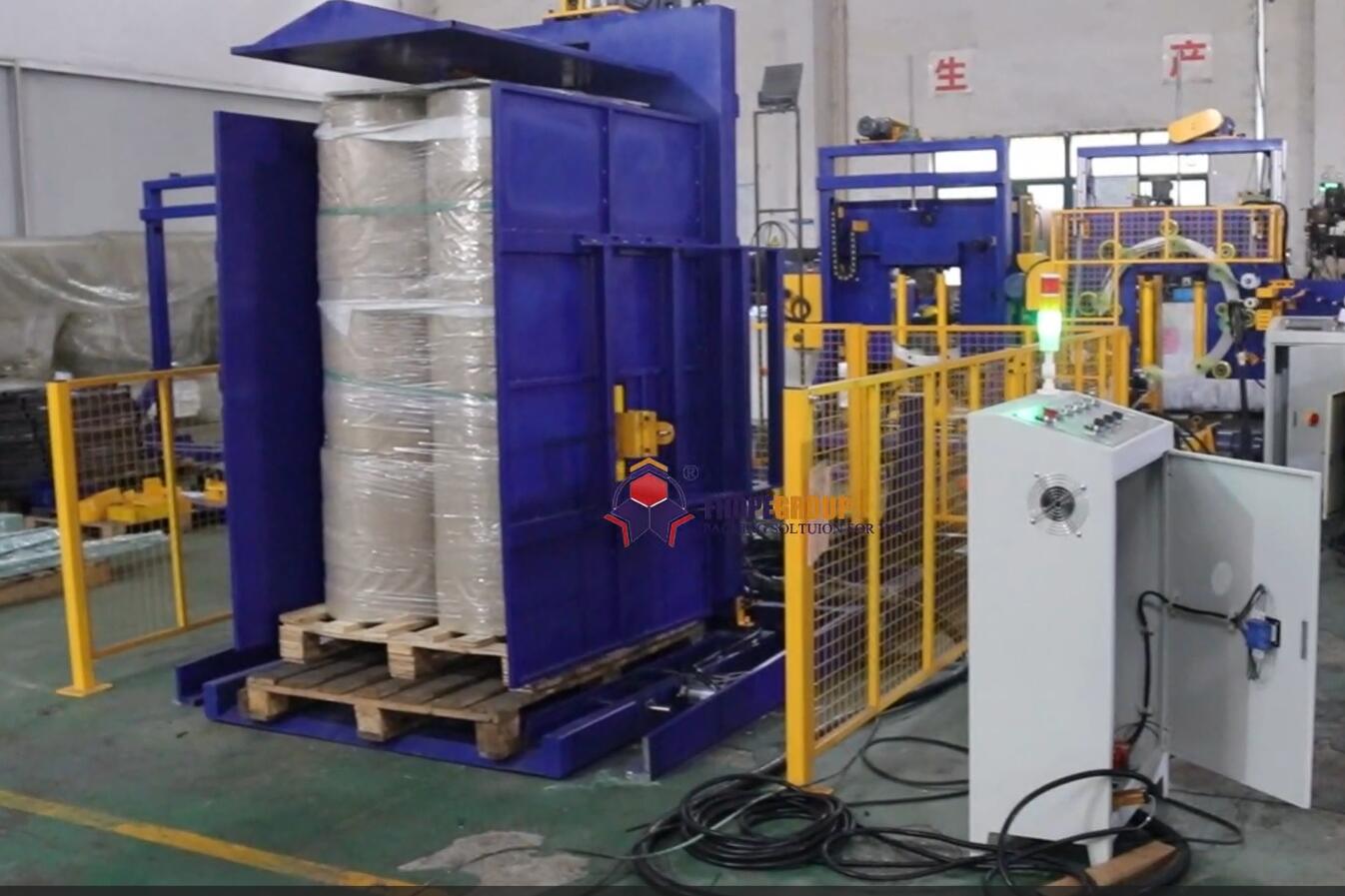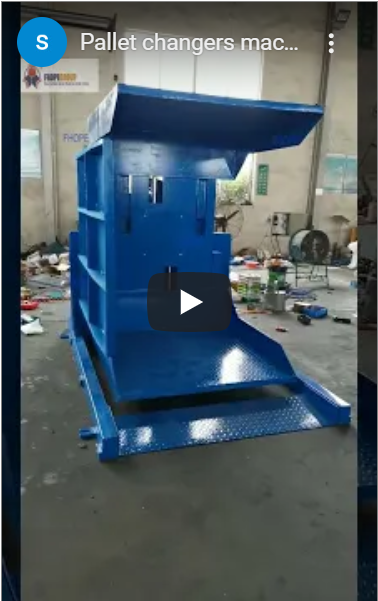Modern logistics, warehousing, and manufacturing operations demand efficiency, safety, and flexibility. The pallet changer machine, also known as a pallet transfer system or load transfer station, has emerged as a critical piece of equipment for optimizing how goods are handled between different types of pallets or slip sheets. This article delves into the technical specifications, design considerations, operational benefits, and real-world applications of pallet changer machines, providing valuable insights for professionals seeking to enhance their material handling processes.
1. Understanding the Pallet Changer Machine
A pallet changer machine is an automated or semi-automated system designed to transfer a fully loaded pallet's contents onto a different pallet (e.g., from a wooden warehouse pallet to a plastic hygienic pallet, or vice-versa) or slip sheet without manual intervention. This process is crucial in various scenarios, including:
- Internal Logistics: Switching to captive in-house pallets.
- Shipping & Receiving: Transferring loads from/to shipping pallets.
- Hygiene Control: Moving goods onto sanitized pallets for cleanroom environments (e.g., food, pharmaceutical).
- Damage Prevention: Replacing broken or unsuitable pallets under a load.
- Export Requirements: Complying with ISPM-15 regulations by switching from wood to plastic or treated pallets.
2. Core Benefits of Implementing Pallet Changers
Integrating a pallet changer into your workflow offers significant advantages:
- Enhanced Safety: Eliminates the need for manual restacking of heavy or unstable loads, drastically reducing the risk of musculoskeletal injuries. Automated clamping and transfer sequences minimize human interaction during the operation.
- Increased Productivity: Significantly faster than manual methods, automated pallet changers can complete a transfer cycle in typically 60-120 seconds, boosting throughput.
- Reduced Product Damage: Gentle and controlled load handling minimizes the risk of damage that can occur during manual transfers or when using less sophisticated methods.
- Improved Hygiene: Facilitates easy transfer to sanitized pallets required in food, beverage, and pharmaceutical industries, preventing cross-contamination.
- Labor Optimization: Frees up personnel previously occupied with manual pallet swapping for more value-added tasks.
- Pallet Fleet Management: Allows for efficient management of internal pallet pools and avoids shipping out expensive or specialized pallets.
3. Technical Deep Dive: Design, Components, and Data

Pallet changers vary in design, but most rely on core principles and components:
3.1 Design Principles and Common Types
- Clamping & Tilting (Inverter Style): The load is clamped securely between two platforms, often inverted (rotated 90° or 180°), allowing the original pallet to be removed and replaced. Suitable for robust, stable loads.
- Pusher Type: A pusher mechanism slides the load from the source pallet onto the destination pallet, often assisted by a retaining wall. Effective for block-stacked goods.
- Gripper Style: Side walls or top clamps grip the load, lift it slightly, allowing the pallets to be exchanged underneath. Versatile for various load types.
- Floor-Level Loading: Machines designed for pallet jack access, eliminating the need for forklifts during loading/unloading.
- Freezer-Rated Models: Specifically designed with components and materials suitable for operation in cold storage environments (e.g., down to -30°C).
3.2 Key Components
- Frame & Structure: Heavy-duty steel construction designed for stability and longevity under demanding industrial use.
- Clamping System: Hydraulic or electric-powered side walls and/or top plates that securely hold the load during transfer. Pressure regulation is key to preventing product damage.
- Drive System: Typically hydraulic power packs for high clamping force or electric motors/actuators for cleaner operation, often preferred in hygiene-sensitive areas.
- Control System: Programmable Logic Controller (PLC) managing the operational sequence, safety interlocks, and user interface (HMI - Human Machine Interface). Common PLCs include Siemens, Allen-Bradley.
- Conveyors (Optional): Integrated powered or gravity conveyors for automated loading and unloading, creating fully inline systems.
- Safety Features: Light curtains, safety fencing, emergency stops, pressure sensors, and door interlocks are crucial for operator protection and compliance (e.g., CE marking, ANSI/RIA standards).
3.3 Typical Performance Data Comparison (Representative Ranges)
| Feature | Typical Range / Options | Considerations |
|---|---|---|
| Load Capacity | 1000 kg - 2500 kg (2200 lbs - 5500 lbs) | Must exceed maximum anticipated load weight. |
| Pallet Size Accepted | EURO (1200x800), GMA (48x40"), CHEP, custom | Machine adjustability or fixed configuration. |
| Maximum Load Height | 1200 mm - 2400 mm (47" - 94") | Ensure compatibility with tallest loads. |
| Cycle Time | 45 - 120 seconds (model/automation dependent) | Impacts overall throughput capacity. |
| Operation Mode | Semi-Automatic, Fully Automatic | Level of operator involvement required. |
| Power Requirements | 3-Phase 230/460V, 50/60Hz | Varies by drive system (hydraulic/electric). |
| Control Interface | Push-button panel, Touchscreen HMI | Ease of use, diagnostics, programming options. |
| Footprint (Approx.) | 3m x 3m to 5m x 5m (Varies greatly) | Space availability in the facility. |
| Environment Suitability | Ambient, Cold Storage (-30°C), Cleanroom | Material selection, component protection (IP rating). |
Note: Specifications vary significantly between manufacturers and models. Always consult specific machine documentation.
4. Operational Considerations and User Experience
From a user perspective, several factors influence the successful integration of a pallet changer:
- Ease of Use: Modern machines often feature intuitive HMIs with pre-programmed cycles, minimizing operator training requirements.
- Integration: Can the machine operate standalone, or does it need integration with existing conveyor lines, AGVs, or WMS (Warehouse Management Systems)? This impacts complexity and cost.
- Maintenance: Regular maintenance schedules are crucial for reliability. Look for designs that offer easy access to key components like hydraulics, motors, and sensors. Consider manufacturers' support and parts availability.
- Flexibility: How easily can the machine adapt to different pallet types or load dimensions if operational needs change? Some offer adjustable clamping or multiple program settings.
5. Applications Across Industries
Pallet changers are indispensable in sectors such as:
- Food and Beverage: Ensuring hygienic transfer from wooden to plastic pallets before entering production areas.
- Pharmaceuticals: Meeting stringent cleanroom standards and preventing contamination.
- Chemicals: Safely handling bagged or containerized goods and managing pallet types.
- Logistics and Distribution: Efficiently swapping pallets at cross-docking facilities or distribution centers.
- Manufacturing: Integrating with production lines to switch pallet types for internal handling or outbound shipping.
- Cold Storage: Using specialized freezer-rated models to maintain the cold chain during pallet transfer.
6. Choosing the Right Pallet Changer
Selecting the optimal pallet changer involves evaluating:
- Load Characteristics: Weight, height, stability, packaging type (boxes, bags, drums).
- Throughput Needs: How many pallets per hour/shift need processing?
- Pallet Types: Specific dimensions and types of source/destination pallets.
- Operating Environment: Temperature, hygiene requirements (washdown?).
- Automation Level: Standalone manual load, semi-automated, or fully integrated inline system.
- Space Constraints: Available floor space and ceiling height.
- Budget: Initial investment versus long-term ROI (labor savings, damage reduction).
Conclusion
The pallet changer machine is far more than just a handling convenience; it's a strategic investment in operational efficiency, worker safety, and product integrity. By understanding the underlying technology, available configurations, and key performance metrics, businesses can select and implement pallet transfer solutions that deliver tangible benefits. Whether addressing hygiene regulations, improving logistics flow, or reducing manual handling risks, the right pallet changer provides a robust and reliable solution for modern material handling challenges.
Explore various pallet inverter and changer models:
https://www.fhopepack.com/pallet-inverter/changer/


